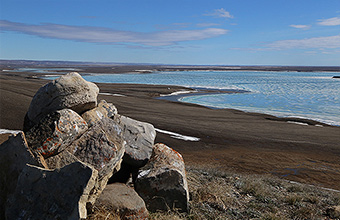
Protected Areas
##Canadian Protected Areas Protected areas are regions that have received special designations that offer different levels of protection, including limiting or restricting development activities to certain areas or seasons.
The Canadian Beaufort Sea is home to a number of smaller protected areas, including five migratory bird sanctuaries in the Inuvialuit Settlement Region (ISR) alone, among 17 in the Northwest Territories.
Inuvialuit have shown strong leadership in conservation to protect important areas for species and subsistence use. They have established extensive conservation areas through land claims, including Ivvavik and Aulavik National Parks.
###Importance
Protected areas are designated to protect rich and important wildlife habitats. Aulavik National Park includes a range of landscapes and is home to many significant species; Ivvavik National Park hosts important caribou breeding grounds.
###Potential impact of an oil spill
An oil spill could damage protected areas valuable to both wildlife and local residents, and an essential part of Canada’s National identity. These regions are remote, with challenging environmental conditions and sensitive habitats, which would make any cleanup attemempts particularly challenging.
Sources
- Beaufort Sea Partnership – Tarium Niryutait Marine Protected Area
- Beaufort Sea Partnership – Anuniaqvia Niqiqyuam Area of Interest
- Parks Canada
- Parks Canada - Ivaavik National Park
- Parks Canada - Aulavik National Park
- MAP DATA: Conservation Areas Reporting and Tracking System (CARTS) - Canadian Council on Ecological Areas (CCEA), 2010 / International Union for Conservation of Nature (IUCN) and United Nations Environment Programme (UNEP), 2010
- MAP DATA: Fisheries and Oceans Canada, 2008
##Alaskan Protected Areas Alaska is home to 32 state game refuges, critical habitat areas, and wildlife sanctuaries. Protected areas include the Arctic National Wildlife Refuge, which covers over 19 million acres of land and water in northeastern Alaska.
###Importance Protected areas are designated to protect rich and important wildlife habitats. The Arctic National Wildlife Refuge supports 45 species of land and marine mammals, 36 species of fish, and more than more than 200 species of birds from six continents.
Sources
- Arctic National Wildlife Refuge
- Alaska Department of Fish and Game
- MAP DATA: Alaska Department of Natural Resources, Bureau of Land Management, US Fish & Wildlife, National Park Service, National Forest Service, Alaska Department of Fish & Game, 2006